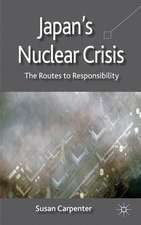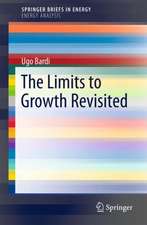Climate Policy Assessment: Asia-Pacific Integrated Modeling
Editat de Mikiko Kainuma, Yuzuru Matsuoka, Tsuneyuki Moritaen Limba Engleză Hardback – 7 oct 2002
| Toate formatele și edițiile | Preț | Express |
|---|---|---|
| Paperback (1) | 951.29 lei 6-8 săpt. | |
| Springer – 22 oct 2012 | 951.29 lei 6-8 săpt. | |
| Hardback (1) | 958.38 lei 6-8 săpt. | |
| Springer – 7 oct 2002 | 958.38 lei 6-8 săpt. |
Preț: 958.38 lei
Preț vechi: 1168.76 lei
-18% Nou
Puncte Express: 1438
Preț estimativ în valută:
183.38€ • 191.47$ • 151.77£
183.38€ • 191.47$ • 151.77£
Carte tipărită la comandă
Livrare economică 05-19 aprilie
Preluare comenzi: 021 569.72.76
Specificații
ISBN-13: 9784431702641
ISBN-10: 4431702644
Pagini: 440
Ilustrații: XXXII, 402 p.
Dimensiuni: 155 x 235 x 32 mm
Greutate: 0.82 kg
Ediția:2003
Editura: Springer
Colecția Springer
Locul publicării:Tokyo, Japan
ISBN-10: 4431702644
Pagini: 440
Ilustrații: XXXII, 402 p.
Dimensiuni: 155 x 235 x 32 mm
Greutate: 0.82 kg
Ediția:2003
Editura: Springer
Colecția Springer
Locul publicării:Tokyo, Japan
Public țintă
ResearchDescriere
The Asia–Pacific Integrated Model (AIM) brings together more than 20 computer simulation models for development and analysis of policy in such diverse fields as climate change mitigation, air pollution abatement, and ecosystem preservation. This first book in a series on the development of AIM focuses on climate change issues and the evaluation of policy options to stabilize the global climate. It presents an overview of the models developed to date, their structure, and the results and analyses presented to policymakers and researchers at the levels of individual Asian countries, the Asia–Pacific region, and the world at large. The contents vary in scope from local to global issues, with discussions of the effects of climate policies, cost analyses of climate policies with their effects on trade, and global scenario analyses. Also included are impact analyses and the effects of promoting environmental technologies.
Cuprins
I. Introduction and Overview.- 1. AIM Modeling: Overview and Major Findings.- Summary.- 1.1 Introduction.- 1.2 Integrated Assessment Approach and AIM.- 1.3 Structure of the AIM Model.- 1.4 Major Findings.- References.- II. Global Modeling and Application.- 2. Long-term Scenarios based on AIM Model.- Summary.- 2.1 Introduction.- 2.2 SRES Scenarios.- 2.3 Model Description.- 2.4 Emissions Scenarios without Climate Change Policies.- 2.5 Emissions Scenarios with Climate Policies.- 2.6 Findings.- 2.7 Conclusions.- References.- 3. Potential Impacts of Global Climate Change.- Summary.- 3.1 Introduction.- 3.2 Framework of AIM/Impact Model.- 3.3 Agriculture.- 3.4 Vegetation.- 3.5 Health.- 3.6 Water.- 3.7 Climate Change Scenarios used in AIM/Impact.- 3.8 Future Direction for Model Improvement.- References.- 4. Cost Analysis of Mitigation Policies.- Summary.- 4.1 Introduction.- 4.2 Structure of AIM/CGE (Energy) for Mitigation Analysis.- 4.3 Costs of the Kyoto Protocol.- 4.4 Long-term Emissions Reduction Scenarios.- 4.5 Concluding Remarks.- References.- III. Regional and Country Modeling.- 5. Application of AIM/Enduse Model to China.- Summary.- 5.1 Introduction.- 5.2 Input Assumptions and Simulations.- 5.3 Simulation Results.- 5.4 Findings and Conclusion.- References.- 6. Application of AIM/Local Model to India using Area and Large Point Sources.- Summary.- 6.1 Introduction.- 6.2 Methodology.- 6.3 Data Sources and Coverage.- 6.4 Results.- 6.5 Conclusions.- References.- Appendix: AIM/Local Modeling Approach.- 7. Methodology for Exploring Co-benefits of CO2 and SO2 Mitigation Policies in India using AIM/Enduse Model.- Summary.- 7.1 Introduction.- 7.2 Bottom-up Modeling Framework.- 7.3 Design of Scenarios.- 7.4 Results and Analysis.- 7.5 Concluding Remarks.- References.- 8. Application of AIM/Enduse Model to Korea.- Summary.- 8.1 Introduction.- 8.2 AIM-Korea Model and Data.- 8.3 Simulation using AIM-Korea Model.- 8.4 Discussion.- References.- 9. Application of AIM/Enduse to Vietnam: A Study on Effects of CO2 Emission Reduction Targets.- Summary.- 9.1 Introduction.- 9.2 Structure of AIM/Enduse Model for Vietnam.- 9.3 Scenarios.- 9.4 Data and Assumptions.- 9.5 Simulation Results.- 9.6 Conclusions.- References.- 10. Application of AIM/Enduse Model to Japan.- Summary.- 10.1 Introduction.- 10.2 Application to Analysis of the Effects of Carbon Tax and Subsidies in Japan.- 10.3 Application of Analysis of Ancillary Benefits in Prefectures.- 10.4 Development of CO2 Emission Scenarios in Japan.- 10.5 Concluding Remarks.- References.- 11. AIM/Material Model.- Summary.- 11.1 Introduction.- 11.2 Structure of AIM/Material Model.- 11.3 Application of AIM/Material to Japan.- 11.4 Application of AIM/Material to India.- 11.5 Conclusion.- References.- 12. Impact and Adaptation Assessment on a National Scale: Case Studies on Water in China.- Summary.- 12.1 Introduction and Framework of AIM/Impact [Country].- 12.2 Projection of Water Demand through.- 12.3 Adaptation Policies in China for Mitigating Flood Damage.- Conclusion.- References.- 13. IM/Trend: Policy Interface.- Summary.- 13.1 Introduction.- 13.2 Structure of AIM/Trend Model.- 13.3 Middle-term Economy, Energy, Environment Scenario Simulation in the Asia-Pacific Region.- Concluding Remarks.- References.- 14. AIM/Common Database: A Tool for AIM Family Linkage.- Summary.- 14.1 Background.- 14.2 Outline of AIM/Database.- 14.3 AIM/Primary Database.- 14.4 AIM/Common Database.- 14.5 Development and Management of AIM/Common Database.- 14.6 An Example: How to Interact with AIM Family Models.- 14.7 Concluding Remarks.- References.- IV. Manual.- A Guide to AIM/Enduse model.- 1. AIM/Enduse: An Overview.- 1.1 Introduction.- 1.2 Concept of the Model.- 1.3 AIM/Enduse Software.- 2. Theoretical Formulation of AIM/Enduse.- 2.1 Indices and Sets.- 2.2 Expression for Emission Quantity Estimation.- 2.3 Expressions for Constraints.- 2.4 Internal Service and Internal Energy Balance.- 2.5 Stock Balance.- 2.6 Expressions for Cost.- 2.7 Objective function.- 3. Methodology for Data Preparation.- 3.1 Choice of Start Year, End Year, and Discount Rate.- 3.2 Classification of Region, Energy, Sectors and Services.- 3.3 Classification and Definition of Technologies.- 3.4 Estimation of Data for Start Year.- 3.5 Projection of Service Demands.- 3.6 Projection of Improvement in Devices.- 3.7 Projection of Maximum Share of Devices.- 4. Illustration of AIM-India.- 4.1 Start Year, End Year, and Discount rate.- 4.2 Choice of Sectors and Services.- 4.3 Classification and Definition of Technologies.- 4.4 Estimation of Data for Start Year.- 4.5 Projection of Service Demands.- 4.6 Improvement of Technological Performance and Service Efficiency.- 4.7 Design of Scenarios.- 4.8 Tentative Results from AIM-India.- 5. Illustration of AIM-Japan.- 5.1 Start Year, End Year, and Discount Rate.- 5.2 Choice of Sectors and Services.- 5.3 Estimation of Energy Data.- 5.4 Classification and Definition of Technology Systems.- 5.5 Estimation of Energy Device Data.- 5.6 Projection of Service Demands.- 5.7 Case Study of AIM-Japan.- References.- Appendix A: Terms of Reference.- Appendix B: Description of GAMS Files and Code.- Appendix C: AIM/Enduse Database System and Implementation.- Appendix D: Possible Classifications for Sectors and Services.- Appendix E: Partial List of Internationally Published Sources of Relevant Data.- Appendix F: Characteristics of Selected Technologies.- Appendix G: Typical Numbers for Characteristics of Some Removal Processes.- Appendix H: Calorific Value, Price, and Emission Coefficients of Energy Kinds.- Appendix I: Units and Conversions.- Appendix J: Representation of Technology Systems in AIM-India.- Appendix K: Characteristics of Technologies in AIM-India.- Appendix L: Representation of Technology Systems in AIM-Japan.- Appendix M: Characteristics of Technologies in AIM-Japan.
Caracteristici
Presenting an overview of the models developed to date, their structure, and the results and analyses presented to policymakers and researchers at the levels of individual Asian countries, the Asia–Pacific region, and the world at large










